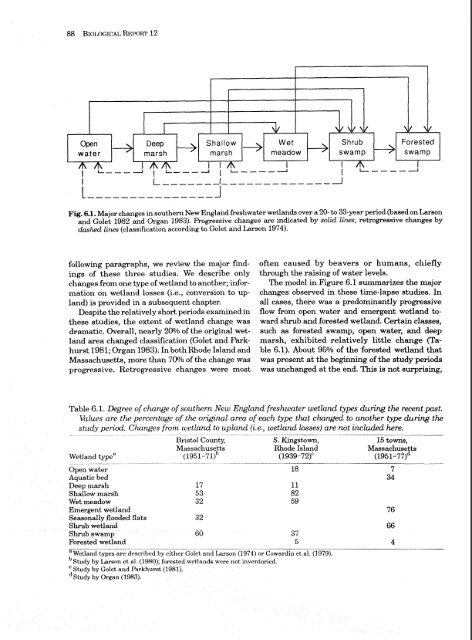Ecology of Red Maple Swamps in the Glaciated Northeast: A ...
Ecology of Red Maple Swamps in the Glaciated Northeast: A ...
Ecology of Red Maple Swamps in the Glaciated Northeast: A ...
Create successful ePaper yourself
Turn your PDF publications into a flip-book with our unique Google optimized e-Paper software.
Fig. 6.1. Major changes <strong>in</strong> sou<strong>the</strong>rn New England freshwater wetlands over a 20- to 33-year period (based on Larson<br />
and Golet 1982 and Organ 1983). Progressive changes are <strong>in</strong>dicahd by solid l<strong>in</strong>es, retrogressive changes by<br />
&-lted l<strong>in</strong>es (classification accord<strong>in</strong>g to Golet and Larson 1974).<br />
follow<strong>in</strong>g paragraphs, we review <strong>the</strong> major f<strong>in</strong>d<strong>in</strong>gs<br />
<strong>of</strong> <strong>the</strong>se three studies. We describe only<br />
changes from one type <strong>of</strong> wetland to ano<strong>the</strong>r; <strong>in</strong>formation<br />
on wetland losses (i.e., conversion to upland)<br />
is provided <strong>in</strong> a subsequent chapter.<br />
Despite <strong>the</strong> relatively short periods exam<strong>in</strong>ed <strong>in</strong><br />
<strong>the</strong>se studies, <strong>the</strong> extent <strong>of</strong> wetland change was<br />
dramatic. Overall, nearly 20% <strong>of</strong> <strong>the</strong> orig<strong>in</strong>al wetland<br />
area changed classification (Golet and Parkhurst<br />
1981; Organ 1983). In both Rhode Island and<br />
Massachusetts, more than 700h <strong>of</strong> <strong>the</strong> change was<br />
progressive. Retrogressive changes were most<br />
<strong>of</strong>ten caused by beavers or humans, chiefly<br />
through <strong>the</strong> rais<strong>in</strong>g <strong>of</strong> water levels.<br />
The model <strong>in</strong> Figure 6.1 summarizes <strong>the</strong> major<br />
changes observed <strong>in</strong> <strong>the</strong>se time-lapse studies. In<br />
all cases, <strong>the</strong>re was a predom<strong>in</strong>antly progressive<br />
flow from open water and emergent wetland toward<br />
shrub and forested wetland. Certa<strong>in</strong> classes,<br />
such as forested swamp, open water, and deep<br />
marsh, exhibited relatively little change (Table<br />
6.1). About 95% <strong>of</strong> <strong>the</strong> forested wetland that<br />
was present at <strong>the</strong> beg<strong>in</strong>n<strong>in</strong>g <strong>of</strong> <strong>the</strong> study periods<br />
was unchanged at <strong>the</strong> end. This is not surpris<strong>in</strong>g,<br />
Table 6.1, hgrce <strong>of</strong> charge <strong>of</strong> sou<strong>the</strong>rn New England freshwater wetland types dur<strong>in</strong>g <strong>the</strong> recent past.<br />
Values are <strong>the</strong> percentage <strong>of</strong> <strong>the</strong> orig<strong>in</strong>al area <strong>of</strong> each type that changed to ano<strong>the</strong>r type dur<strong>in</strong>g <strong>the</strong><br />
nd bsses) are not <strong>in</strong>cluded here.<br />
15 tom-,<br />
Magsachuse ts<br />
(1951-77) d<br />
7<br />
34<br />
Deep n~srvh 17 11<br />
Shallow marsh 53 82<br />
Wet meadow 32 59<br />
Emergent wetland 76<br />
32<br />
66<br />
ti0 37<br />
Forested wetland<br />
- -- - -- --- --- 5 4<br />
--<br />
"Wetland types are described by ei<strong>the</strong>r Golet and I~rson (1974) or Coward<strong>in</strong> et al. (1979).<br />
'~tudy by Imon et at. (1980); forested wrtlnrlds wwe not <strong>in</strong>ventoried.<br />
Study by Colet and Parkhurst (1981).<br />
d~tudy by Organ (1983).

















